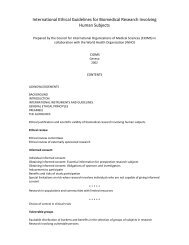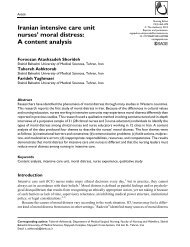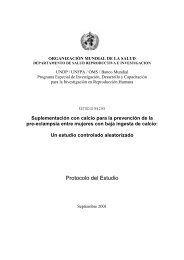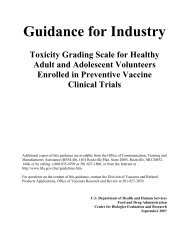03-00 THERAPY CHAPTER – INTRODUCTION - Global Health Trials
03-00 THERAPY CHAPTER – INTRODUCTION - Global Health Trials
03-00 THERAPY CHAPTER – INTRODUCTION - Global Health Trials
Create successful ePaper yourself
Turn your PDF publications into a flip-book with our unique Google optimized e-Paper software.
This section is about the external person(s) who serve the patients and investigators in RCTs by<br />
alerting them as soon as clear-cut evidence emerges about the safety or efficacy of the<br />
experimental treatment, or about the futility of continuing an indeterminate trial. These groups<br />
bear a wide array of names and acronyms, and Susan Ellenberg’s collection 1 appears in Table<br />
<strong>03</strong>-16-1. Some of the more common monikers are Data, Safety, and Monitoring Board (DSMB);<br />
Data Monitoring Committee (DMC); and Trial Monitoring Committee (TMC). In this section, I’ll<br />
use the last term: TMC.<br />
Table <strong>03</strong>-16-1: Names assigned to monitoring groups<br />
Subject Function Organization<br />
Trial<br />
Data<br />
Safety<br />
Monitoring<br />
Review<br />
Advisory<br />
Committee<br />
Board<br />
Panel<br />
Policy<br />
Efficacy<br />
Endpoint<br />
Ethics<br />
Adapted from Ellenberg SS. Independent data monitoring committees: rationale, operations and<br />
controversies. Stat Med 2<strong>00</strong>1;20:2573-83.<br />
If this section whets your interest in TMCs, or it becomes clear that you need one for your RCT,<br />
there are two very good resources where you can learn more about them. The first is a book by<br />
Susan Ellenberg, Thomas Fleming, and David DeMets 2 , and the second is a report from the UK<br />
DAMOCLES project 3 that carried out a systematic review and several interviews on issues in data<br />
monitoring and the interim analysis of RCTs.<br />
Monitoring Check List:<br />
1 Can you justify not monitoring your RCT for safety, efficacy and futility<br />
If you decide to monitor your RCT:<br />
2 Specify the precise functions you want your monitor(s) to carry out<br />
3 Establish requirements for monitor(s) in terms of expertise, experience, and freedom from<br />
conflicts of interest.<br />
4 Recruit your monitor(s) and work with them to establish policies and procedures<br />
5 Get on with it.<br />
1. Can you justify not monitoring your RCT for safety, efficacy and futility<br />
Current opinion among trialists is that virtually every RCT needs external monitoring for safety,<br />
efficacy and futility (for example, the British MRC made monitoring of its trials mandatory in<br />
1998). Current opinion also dictates that this monitoring be done by an individual or group who<br />
have no personal interest in its outcome. As shown in the third scenario above, this doesn’t<br />
mean that every RCT needs a full-blown TMC. A single individual often can carry out these<br />
functions.<br />
Exceptions to the need for monitoring are rare, but do occur. In some cases, monitoring is not<br />
necessary because no patients are at risk. An example here is an RCT that randomizes<br />
clinicians to receive the same efficacy information in relative or absolute terms, in order to<br />
determine whether these different formats lead to different conclusions about efficacy.<br />
In other cases, monitoring is not feasible because all study patients have already been recruited<br />
and treated (and perhaps have experienced outcomes) before any monitoring function could be<br />
launched. One example here would be a single RCT of sufficient size to determine whether<br />
Page 2 of 7












